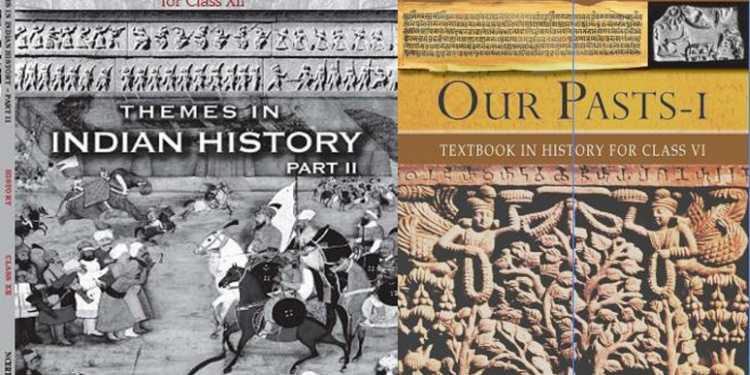We have always trusted historians to record and report history truthfully and without bias. In India too, during British rule, historians generally gave an accurate narrative, be it about the Rajput rulers who fought against Mughals and Turks, or about the invaders themselves. During the British Raj, every text book had lessons from the Indian epics – the Ramayan and Mahabharat. Unfortunately, the paradigm appears to have shifted post independence. All of a sudden, historians weren’t really just unbiased observers and reporters of momentous events in our country and its religious or political fabric. It almost feels as if leftists have been assigned the job of writing and often times even rewriting history!
This shift has impacted the education system as well. It is often said that the winner in a war gets to write history from their perspective. The loser’s perspective is most often lost. However, here it seems to be pure politics that has impacted the writing and teaching of history. School text books were being written and edited with a narrative that is biased or sometimes even downright false. Events were distorted and narratives dissected towards a particular viewpoint in order to keep the political high command happy. The symbiosis is complete when, as rewards, these historians would be showered with awards and lucrative everlasting jobs. Examples are openly leftist historians like Romila Thapar, and Irfan Habib, who have ruled the roost over 4 decades – devising a school curricula which has blatantly falsified Indian history – glorifying Mughal rulers and invaders while unabashedly ignoring the heroism of Hindu rulers and other victims, who were tortured by the invaders including the British.
This unholy alliance of leftists, politicians, academicians and media has deprived generations of students of learning of our glorious heritage dating back over 5,000 years. It is quite disconcerting that the present day NCERT writers do not want to even mention the Indian epics, or Indian heroes! These writers project those who fought valiantly against foreign invaders, who had immense patriotism and osten made the ultimate sacrifice for their motherland, losing life and limb by the thousands, as mediocre – both as rulers and soldiers! And, yet these very same writers have been quick in giving pride of place to some post independence politicians – hailing them as a saviors of Indian culture, democracy and independence.
I was looking through the Indian History text book prescribed by ICSE board for 8th standard – and noticed that not only was Jawaharlal Nehru’s photograph on the cover – but even in the chapter on ‘Civics’ – it was just his picture being prominently displayed.
Our children are not being taught about – let alone encouraged to respect and revere the contributions of Shivaji, Maharana Pratap or more recently the epic roles played by Azad, Bhagat Singh, Bose, Patel, etc in our Independence. Sadly, the leftists’ love and admiration for the Mughal rulers is so obvious that recently Aakar Patel put Aurangzeb and King Ashoka on the same pedestal as being great warriors and administrators [Mint Lounge dated 4.6.2016]. Aurangzeb and Ashoka? Really, Aakar Patel?
I started out this article in an attempt to give my grandchildren a perspective sadly missed by the history text books. To tell them, India, Hindustan, Bharat had so many, many heroes who loved her and shaped her into the glorious country she is and wants to be. I wanted them to be proud of their heritage and do their part to make it greater still. And, I wanted to do my part in portraying and recognizing the sheer bravery, valour, heroism and sometimes even the torture that some of our brave souls underwent at the hands of foreign invaders. Especially since, to add insult to injury, these great people have largely been ignored, belittled and trivialized by the coterie of cabals comprising of the Congress Government appointed leftist historians.
[1] Prithviraj Chauhan
He was the last Hindu king ruling over Ajmer and Delhi in the 12thcentury. He inherited the throne at the very tender age of 13. He united Hindu rulers against Turkish invasions. Prithviraj succeeded in preventing Shahabuddin Ghori from advancing into Hindustan. It was in the first battle of Tarain that he defeated Ghori and forced him to retreat along with his huge army. In a typical showing of Rajput Chivalry, Prithviraj did not pursue Ghori army in its retreat. He paid a heavy price, as this invader reassembled his army of 120,000 men and led them into a second battle, in which Prithviraj was defeated and captured. As a prisoner of war and the leader of the opposing army, instead of being shown the same respect that he had displayed earlier, he was subjected to the most inhumane torture, and blinded with red hot iron rods before finally being executed.
[2] Rana Sanga
He is described as the crown on the pinnacle of Mewar glory, as he controlled large part of Rajasthan in 16th century. Babur who was ruling over Delhi marched to attack him, but Sanga thwarted the advance of the Tartars and entirely destroyed them. Babur’s reinforcements too met with the same fate. Following this victory, unfortunately, he became too complacent. This proved advantageous to the Tartars, who regrouped and marched back into battle. During this battle, Sanga was crippled – losing an an eye and an arm! Michael Todd, in his book, “Annals of Rajasthan” says Rana Sanga had “80 wounds on various parts of his body”
[3] Maharana Pratap
He was a ruler of Mewar having a capital at Chittor. He was a fearless warrior and a great strategist who fought the Mughals till the very end of his life. He was barely 27 when his kingdom was surrounded by the Mughal forces of Akbar, resulting in the famous battle of Haldighat. In this battle, 20,000 Rajput warriors faced 80,000 men of Mughal forces. Though the outcome of the battle itself was indecisive, Rana Pratap was surrounded by the enemy and ultimately saved by his estranged brother. Akbar tried several more times to take over Mewar, but failed in all his successive attempts. Legend has it that this great warrior, during these difficult times, had to eat and feed his children chapattis made out of grass! And, yet he never compromised with his principles of not to surrender, continued to wage guerilla warfare, as a result of which, he regained a large part of what he had lost earlier, including Udaipur.
[4] Marathas
While the role of Shivaji, as the the founder of the Maratha empire, has been acknowledged in our text books, his son Sambhaji is given barely any credit. This despite the fact that following Shivaji’s death, Sambhaji ascended the throne of Maratha empire and fought a series of battles against the Mughals under Auragzeb. It was during one of these battles that he was captured alive and taken prisoner. When presented at the court of Aurangzeb, he was subjected to insults and inhuman treatment before being executed. Though the accounts are at variance about how he was executed, generally all agree that he was tortured (which included plucking his eyes, his nails, and removing his skin) for a fortnight ,before death mercifully came in the form of beheading with an axe.
Another soldier of the Maratha empire, shining like a glittering star, was Bajirao Peshwa. Bajirai was a general and, appointed as Peshwa at a very young age . He successfully lead many battles against the mighty Nizam, Siddis, Portuguese and finally marched to Mughal empire of Delhi from Pune defeating the combined forces of Nizam and Mughals, who had converged at Bhopal. Though he died at the very young age of 38 years, in his brief military carrier spanning 20 years , he had not lost a single battle – out of the 41 that he fought in.
[5] Martyrdom of Sikh Gurus
Guru Arjundev was the first martyr of the Sikh faith and was instrumental in systemizing the institution of langars as a religious duty, which continues to this day. He was arrested by the Mughal Emperor Jahangir and asked to embrace Islam. When this was not accepted by Guru – he was executed.
Guru Teg Bahadur was the eighth successor of Guru Govind Singh. He travelled extensively to preach the teachings of Sikhism, and became a socio–political challenge to Muslim rule in general and Aurangzeb in particular. Aurangzeb summoned him to Delhi and tried to force him to convert to Islam. On Guru’s refusal to do so, this holy man was tortured for weeks before being executed .
Auranzeb’s army besieged Anandpur which was the homeland of the Sikhs and where Guru Gobind Singh along with his retinue had camped. Two of Guru’s sons – one of whom was barely six years old, were arrested and brought to the Wazir, who threatened them with dire consequences if they refused to convert to Islam. However, true to Sikh tradition, they refused, following which, it was ordered that the children were to be children bricked alive – forcing them to stand between a tiny gap of two walls built around them, where they ultimately died!
[5] Revolutionaries of 1857
Nana Saheb Peshwa, who had a legitimate right to draw a pension from East India Company, was refused the same. This infuriated him, and he revolted, along with others like Rani Lakshibai, Tatia Tope, Mangal Pandey and many others, who rose against British Tyranny.
Laxmibai was the queen of Jhansi state, which was annexed by Britishers after the demise of the King. This antagonized the queen, and she became the leading figure of the rebellion of 1857, and a key symbol of resistance to the British Raj. She defended Jhansi valiantly fighting against British troops who had besieged the city, surrounding it from all sides. In a heroic move, she escaped by jumping the wall on her horse with her toddler son strapped to her back. She moved from place to place, but continued to fight against the British who were pursuing her relentlessly. Finally, she was unhorsed, and wounded critically, sat bleeding on the roadside before succumbing to her injuries. Even the British report comments that “she was the most dangerous of all Indian leaders and a very brave lady.”
[6] Freedom Fighters
The number of people who fought against British Raj are so numerous that volumes can be written on the subject. However, it is despicable that for our Leftist Historians, many of them who made the ultimate sacrifice, just do not matter much.
Yes, during the freedom movement , the contribution of leaders like Mahatma Gandhi , Sardar Patel , Nehru and their contemporaries have been immense and they deservedly have pride of place in Indian history. However, what is also true is that despite being repeatedly jailed – they were treated as political prisoners – and therefore were never subjected to inhuman punishment or torture.
On the other hand, we have many martyrs in Indian history too who were tortured, shot dead, or hanged. Many of these martyrs were barely adults – in their twenties – and yet they seem to have disappeared from the pages of Indian History Text books!
Madanlal Dhingra was one of the first revolutionaries who fought for the freedom from the yoke of British rule. While in England, he fired five shots at Curzon Wyllie following which, instead of running away, he willingly gave himself up and was sentenced to death.
Khudiram Bose was only 18 years old when he was hanged. Chandrasekhar Azad who, encouraged youngsters like Bhagat Singh and Sukhdev to rise against the British , preferred to shoot himself rather than surrender, when surrounded by British soldiers. Bhagat Singh was the most influential revolutionary who, while in jail resorted to 116 days of hunger strike [one of the longest in History], and was hanged along with Raj Guru and Sukhdev on the same day. All three of them welcomed death by putting the noose around their own neck.
Veer Savarkar was arrested in 1910 in England, and while he was being transported, managed to escape from the steamer. He went to France, where, he was once again arrested by the British, and subsequently given a double life term – i.e. – imprisonment totaling 50 years. He was moved to the Andaman Cellular Jail, where he was kept in solitary confinement until the date of his release eleven years later.
It is time to acknowledge the truth
Sanskrit, a Vedic language, seems to be on its way out in our own country, while in Germany it is being taught (and students are signing up in hordes!) at 14 of the top universities. But any attempt to re-introduce it here in the land of its birth, will be labelled “saffronization.” It is a matter of great pride for every Indian that the Government of Netherlands has recently decided to introduce a few select verses of our Bhagwad Geeta in their text books. Can we take inspiration from these countries and start honouring those, and that which deserves to be honoured right here, right now?
Isn’t it preposterous that in some of our Indian History text books, Bhagat Singh is branded as a terrorist? That Shivaji as a mere chieftain? And, Savarkar as a traitor?
The world over, children are taught about their own country and its culture, civilization, heritage and tradition. Isn’t it then a matter of great shame that our children are deprived of learning the beautiful values propagated by Swami Vivekananda , Sri Arbind, the Ramakrishna mission and other saints, philosophers, teachers and preachers?
It is a known fact that of all the Mogul rulers, Aurangzeb was the most cruel – committing heinous, barbaric crimes both in war and peace. And yet, recently when an arterial road in Delhi, that bore his name, was renamed – there was a huge hue and cry against the move. Why? Why would we want to continue to honour a man that hated us, and everything we stood for, and proved it by killing, murdering, maiming and torturing?
It is time that our History text books are rewritten, so our children learn of our rich heritage, and also of the persecution meted out to many of our cultural, political and Historical icons whose names seem to have been by undeniably erased by the leftist historians.
More than 400 Government welfare schemes, monuments, arterial roads, national parks, museums, universities and airports are named after the Nehru-Gandhi family and its descendants. In our long and checkered history, can we not find any other heroes to laud, glorify, and applaud? Do we have such few martyrs that whereever we go, whatever we name – we can only think of Gandhi and the Nehru-Gandhi family? Has no other soldier or civilian honoured this country with his/her service and his/her blood? We’re all grown up now – not at the mercy of those history text books any more. All of us, each and every proud Indian – let us do our own research and be responsible for our own beliefs – and not let half reported, twisted, distorted viewpoints of others dictate how we think, and what we believe. Some food for thought.

































